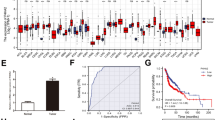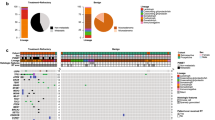Abstract
Purpose
In addition to genetic alterations, the importance of a CpG island methylator phenotype, characterized by methylation of multiple tumour-suppressor genes (TSGs), has been acknowledged in many cancer types. This study was done to determine the impact of genetic and epigenetic patterns on the clinical characteristics of the head and neck paragangliomas (HNPGLs).
Methods
The retrospective study examined a series of 37 patients with HNPGLs who underwent surgical resection between 2010 and 2015. The mutations in the succinate dehydrogenase (SDH) genes were detected using direct DNA sequencing. Aberrant hypermethylation of the CpG islands of a panel of ten TSGs was also analysed using methylation-specific PCR.
Results
Direct sequencing demonstrated the presence of germline SDH mutations in ten HNPGLs. Comparisons of clinical features between mutated and non-mutated HNPGLs established an association of SDH mutations with progressive phenotypes, including an earlier formation, multiple lesions, or malignancy. There was also a significant correlation between the presence of SDH mutations and the number of TSGs methylated in HNPGLs. The SDH-related tumours were therefore more likely to suffer from a CpG island methylator phenotype. Four differentially methylated TSGs in mutated tumours vs non-mutated counterparts were identified with inefficient expression through Real-Time PCR analysis.
Conclusions
Our results suggested that epigenetic inactivation on multiple TSGs may serve as a key mechanism for the progressive behaviors of SDH-mutated HNPGLs. Thus, an interplay between genetic status, epigenetic alterations, and clinical features might be established in the disease.




Similar content being viewed by others
References
Amar L et al (2005) Genetic testing in pheochromocytoma or functional paraganglioma. J Clin Oncol 23:8812–8818. doi:10.1200/JCO.2005.03.1484
Bayley JP, Devilee P, Taschner PE (2005) The SDH mutation database: an online resource for succinate dehydrogenase sequence variants involved in pheochromocytoma, paraganglioma and mitochondrial complex II deficiency. BMC Med Genet 6:39. doi:10.1186/1471-2350-6-39
Baysal BE (2008) Clinical and molecular progress in hereditary paraganglioma. J Med Genet 45:689–694. doi:10.1136/jmg.2008.058560
Baysal BE et al (2000) Mutations in SDHD, a mitochondrial complex II gene, in hereditary paraganglioma. Science 287:848–851
Boedeker CC, Neumann HP, Maier W, Bausch B, Schipper J, Ridder GJ (2007) Malignant head and neck paragangliomas in SDHB mutation carriers. Otolaryngol Head Neck Surg 137:126–129. doi:10.1016/j.otohns.2007.01.015
Burnichon N et al (2009) The succinate dehydrogenase genetic testing in a large prospective series of patients with paragangliomas. J Clin Endocrinol Metab 94:2817–2827. doi:10.1210/jc.2008-2504
Burnichon N et al (2012) MAX and paragangliomamutations cause hereditary and sporadic pheochromocytoma. Clin Cancer Res 18:2828–2837. doi:10.1158/1078-0432
Cascon A et al (2004) Genetic and epigenetic profile of sporadic pheochromocytomas. J Med Genet 41:e30
Costello JF et al (2000) Aberrant CpG-island methylation has non-random and tumour-type-specific patterns. Nat Genet 24:132–138. doi:10.1038/72785
Crona J, Delgado Verdugo A, Maharjan R, Stålberg P, Granberg D, Hellman P, Björklund P (2013) Somatic mutations in H-RAS in sporadic pheochromocytoma and paraganglioma identified by exome sequencing. J Clin Endocrinol Metab 98:E1266–E1271. doi:10.1210/jc.2012-4257
Fishbein L, Nathanson KL (2012) Pheochromoeytoma and paraganglioma: understanding the complexities of the genetic background. Cancer Genet 205:1–11. doi:10.1016/j.cancergen.2012.01.009
Forbes JA, Brock AA, Ghiassi M, Thompson RC, Haynes DS, Tsai BS (2012) Jugulotympanic paragangliomas: 75 years of evolution in understanding. Neurosurg Focus 33:E13. doi:10.3171/2012.6.FOCUS12138
Geli JM et al (2008) Global and regional CpG methylation in pheochromocytomas and abdominal paragangliomas: association to malignant behavior. Clin Cancer Res 14:2551–2559. doi:10.1158/1078-0432.CCR-07-1867
Hadoux J et al (2014) SDHB mutations are associated with response to temozolomide in patients with metastatic pheochromocytoma or paraganglioma. Int J Cancer 135:2711–2720. doi:10.1002/ijc.28913
Heesterman BL et al (2013) High prevalence of occult paragangliomas in asymptomatic carriers of SDHD and SDHB gene mutations. Eur J Hum Genet 21:469–470. doi:10.1038/ejhg.2012.203
Hensen EF et al (2008) Mutations in SDHD are the major determinants of the clinical characteristics of Dutch head and neck paraganglioma patients. Clin Endocrinol (Oxf) 75:650–655. doi:10.1111/j.1365-2265.2011.04097.x
Hinoue T et al (2012) Genome-scale analysis of aberrant DNA methylation in colorectal cancer. Genome Res 22:271–282. doi:10.1101/gr.117523.110
Jones PA, Baylin SB (2007) The epigenomics of cancer. Cell 128:683–692. doi:10.1016/j.cell.2007.01.029
King A, Selak MA, Gottlieb E (2006) Succinate dehydrogenase and fumarate hydratase:1inking mitochondrial dysfunction and cancer. Oncogene 25:4675–4682. doi:10.1038/sj.onc.1209594
Kiss NB et al (2008) Methylation of the p16INK4A promoter is associated with malignant behavior in abdominal extra-adrenal paragangliomas but not pheochromocytomas. Endocr Relat Cancer 2008 15:609–621. doi:10.1677/ERC-07-0285
Letouzé E et al (2013) SDH Mutations establish a hypermethylator phenotype in paraganglioma. Cancer Cell 23:739–752. doi:10.1016/j.ccr.2013.04.018
Margetts CD et al (2013) Epigenetic analysis of HIC1, CASP8, FLIP, TSP1, DCR1, DCR2, DR4, DR5, KvDMR1, H19and preferential 11p15.5 maternal-allele loss in von Hippel-Lindau and sporadic phaeochromocytomas. Endocr Relat Cancer 12:161–172. doi:10.1677/erc.1.00865
Neumann HP et al (2002) Germ-line mutations in nonsyndromic pheochromocytoma. N Engl J Med 346:1459–1466. doi:10.1056/NEJMoa020152
Pasini B, Stratakis CA (2009) SDH mutations in tumorigenesis and inherited endocrine tumours: lesson from the phaeochromocytoma-paraganglioma syndromes. J Intern Med 266:19–42. doi:10.1111/j.1365-2796.2009.02111.x
Ricketts CJ et al (2010) Tumor risks and genotype-phenotype-proteotype analysis in 358 patients with germline mutations in SDHB and SDHD. Hum Mutat 31:41–51. doi:10.1002/humu.21136
Wang CP et al (2011) Common genetic mutations in the start codon of the SDH subunit D gene among Chinese families with familial head and neck paragangliomas. Oral Oncol 48:125–129. doi:10.1016/j.oraloncology.2011.08.025
Welander J et al (2011) Integrative genomic analysis reveals somatic mutations in pheochromocytoma and paraganglioma. Hum Mol Genet 21:5406–5416. doi:10.1093/hmg/ddr324
Welander J et al (2012) Integrative genomics reveals frequent somatic NF1 mutations in sporadic pheochromocytomas. Hum Mol Genet 21:5406–5416. doi:10.1093/hmg/dds402
Zhu WD, Wang ZY, Chai YC, Wang XW, Chen DY, Wu H (2015) Germline mutations and genotype-phenotype associations in head and neck paraganglioma patients with negative family history in China. Eur J Med Genet 58:433–438. doi:10.1016/j.ejmg.2015.05.008
Zhuang Z et al (2012) Somatic HIF2α gain-of-function mutations in paraganglioma and somatostatinoma associated with polycythemia. N Engl J Med 367:922–930. doi:10.1200/JCO.2012.47.1912
Acknowledgements
This research was funded by the National Natural Science Foundation of China (Grant No. 81371086 and Grant No. 81670919 to Zhaoyan Wang, and Grant No. 81570906 to Hao Wu).
Author information
Authors and Affiliations
Corresponding authors
Ethics declarations
Conflict of interest
The authors declare that they have no competing interests.
Ethical approval
All procedures performed in studies involving human participants were in accordance with the ethical standards of the institutional and/or national research committee and with the 1964 Helsinki Declaration and its later amendments or comparable ethical standards.
Informed consent
Informed consent was obtained from all individual participants included in the study.
Additional information
H. Chen, W. Zhu, X. Li and L. Xue contributed equally to this work.
Electronic supplementary material
Below is the link to the electronic supplementary material.
Rights and permissions
About this article
Cite this article
Chen, H., Zhu, W., Li, X. et al. Genetic and epigenetic patterns in patients with the head-and-neck paragangliomas associate with differential clinical characteristics. J Cancer Res Clin Oncol 143, 953–960 (2017). https://doi.org/10.1007/s00432-017-2355-0
Received:
Accepted:
Published:
Issue Date:
DOI: https://doi.org/10.1007/s00432-017-2355-0




